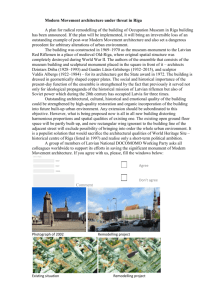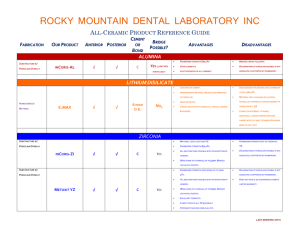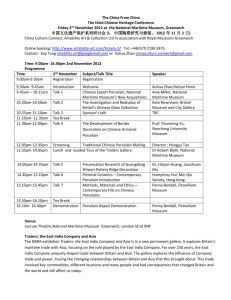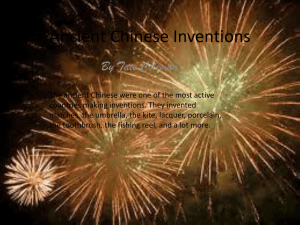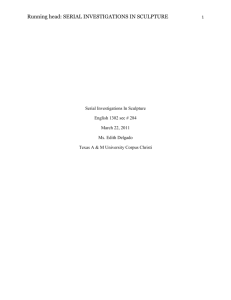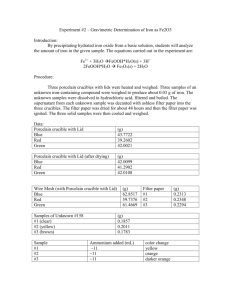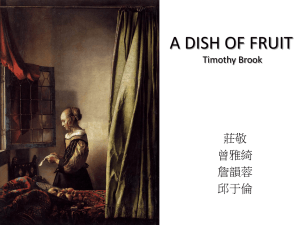Latvijas Nacionālais mākslas muzejs
advertisement
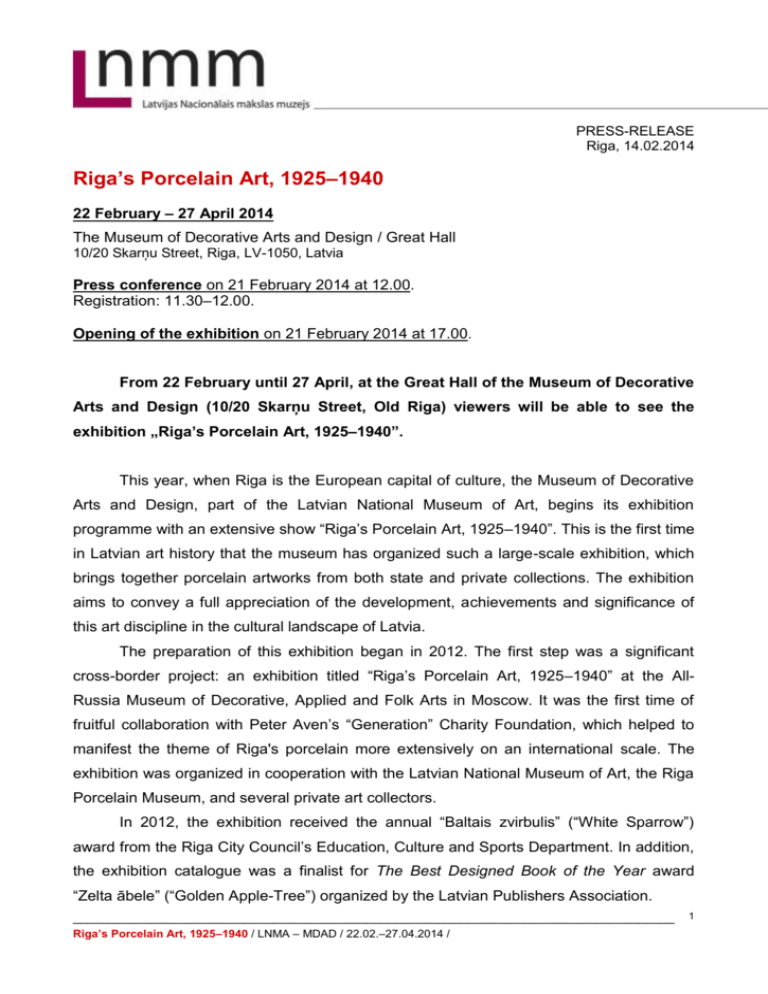
PRESS-RELEASE Riga, 14.02.2014 Riga’s Porcelain Art, 1925–1940 22 February – 27 April 2014 The Museum of Decorative Arts and Design / Great Hall 10/20 Skarņu Street, Riga, LV-1050, Latvia Press conference on 21 February 2014 at 12.00. Registration: 11.30–12.00. Opening of the exhibition on 21 February 2014 at 17.00. From 22 February until 27 April, at the Great Hall of the Museum of Decorative Arts and Design (10/20 Skarņu Street, Old Riga) viewers will be able to see the exhibition „Riga’s Porcelain Art, 1925–1940”. This year, when Riga is the European capital of culture, the Museum of Decorative Arts and Design, part of the Latvian National Museum of Art, begins its exhibition programme with an extensive show “Riga’s Porcelain Art, 1925–1940”. This is the first time in Latvian art history that the museum has organized such a large-scale exhibition, which brings together porcelain artworks from both state and private collections. The exhibition aims to convey a full appreciation of the development, achievements and significance of this art discipline in the cultural landscape of Latvia. The preparation of this exhibition began in 2012. The first step was a significant cross-border project: an exhibition titled “Riga’s Porcelain Art, 1925–1940” at the AllRussia Museum of Decorative, Applied and Folk Arts in Moscow. It was the first time of fruitful collaboration with Peter Aven’s “Generation” Charity Foundation, which helped to manifest the theme of Riga's porcelain more extensively on an international scale. The exhibition was organized in cooperation with the Latvian National Museum of Art, the Riga Porcelain Museum, and several private art collectors. In 2012, the exhibition received the annual “Baltais zvirbulis” (“White Sparrow”) award from the Riga City Council’s Education, Culture and Sports Department. In addition, the exhibition catalogue was a finalist for The Best Designed Book of the Year award “Zelta ābele” (“Golden Apple-Tree”) organized by the Latvian Publishers Association. ____________________________________________________________________________________ Riga’s Porcelain Art, 1925–1940 / LNMA – MDAD / 22.02.–27.04.2014 / 1 The theme of Riga porcelain attracted the attention of Peter Aven, a collector of well-known early 20th century Russian painting and porcelain. Currently there are about 400 items in his collection, including more than 40 works by the artists from the “Baltars” Workshop. This year again the museum has the honour to exhibit artworks from his collection in Riga. The present exhibition basically comprises artworks from the Museum of Decorative Arts and Design, Romans Suta and Aleksandra Beļcova Museum, as well as the Museum of History of Riga and Navigation, the Literature and Music Museum. Numerous outstanding items have been chosen from the Zuzāni family, Guntis Belēvičs', and some other private collections, which are here being shown to the public for the first time. The exhibition introduces viewers to Latvian artists – painters and graphic artists – who, inspired by the establishment of independent Latvian State in 1918, developed new artistic thinking and created sketches for porcelain painting in the 1920s and 30s. It was an unexplored field, where national themes came to be linked with European Modernism. The exhibition particularly emphasizes the legacy of the Porcelain Painting Workshop “Baltars” (from Latin ars Baltica – Baltic art; 1925–1928), whose artworks most vividly express the most remarkable artistic styles and directions of the time, such as Constructivism, Cubism and Art Déco, at the same time amalgamating them with national themes. The “Baltars” porcelain crockery collection, created based on the sketches of the young modernist artists Romans Suta, Aleksandra Beļcova, and Sigismunds Vidbergs, received gold and bronze medals at the International Decorative and Industrial Arts Exhibition in Paris in 1925. The synthesis of modern artistic language, interpretation of national themes, and high technical quality is the reason why “Baltars” porcelain items receive special attention today and are among the most prized creations in the Latvian culture canon. The exhibition also represents two other porcelain workshops of this time: “Burtnieks” (1928–1939), headed by the graphic artist Sigismunds Vidbergs and sponsored by the Latvian press magnates the Benjamiņi family; and “RI PORS” (1933– 1934). The exhibition includes wares from the M. S. Kuznetsov and J. C. Jessen factories, the two outstanding porcelain manufacturing enterprises in Riga. Professional Latvian painters and graphic artists created sketches for these factories, and their active participation stimulated the factories to abandon the old principles of painting and decor printing. As a result, the artistic level of mass-produced wares improved and their quality was acknowledged in prestigious international venues. Acclaim was won in 1935 at the ____________________________________________________________________________________ Riga’s Porcelain Art, 1925–1940 / LNMA – MDAD / 22.02.–27.04.2014 / 2 World Exhibition in Brussels, Belgium, and in 1937 at the International Exhibition of Art and Technology in Paris, France, where the stand of the Kuznetsov factory was awarded a Grand Prix. Finally, the exhibition shows that Riga’s porcelain art is not only a unique local phenomenon, but should also be viewed in its European context. It tells the story of the independent Latvian State in the 1920s and 30s, and shows Riga as a metropolis of European culture. Riga’s porcelain art is defined by its high technical quality and aesthetic excellence – qualities that never go out of style. Text by Dace Ļaviņa CURATORIAL TEAM OF THE EXHIBITION: Inese Baranovska, Dace Ļaviņa, Velta Raudzepa, Ludmila Neimisheva EXHIBITION DESIGNER: Jurģis Krāsons ADDITIONAL INFORMATION: Dace Ļaviņa, Curator of the Latvian Ceramics and Porcelain Collection at the Latvian Decorative Arts and Design Department of the LNMA T: (+371) 67 830904, E: Dace.Lavina@lnmm.lv The Museum of Decorative Arts and Design (10/20 Skarņu Street, Riga, Latvia) OPENING HOURS: Daily 11.00–17.00, ticket office 11.00–16.30 Wednesdays 11.00–19.00, ticket office 11.00–18.30 Closed on Mondays The museum is closed on all public holidays: 1 January, Good Friday, Easter, Midsummer Eve and Day (23– 24 June), Christmas (25–26 December), 31 December. ADMISSION: Individual admission fee for groups of 10 or more people given in brackets. Free admission for group leaders. Adults: EUR 3,56 (2,85) / LVL 2,50 (2,00) Schoolchildren, students, senior citizens: EUR 2,13 (1,42) / LVL 1,50 (1,00) Family ticket (1–2 adults with 1–4 children or family having many children): EUR 5,69 / LVL 4,00 ____________________________________________________________________________________ Riga’s Porcelain Art, 1925–1940 / LNMA – MDAD / 22.02.–27.04.2014 / 3 PRESS IMAGES (please request if need in a larger resolution) 1. Aleksandra Beļcova (1892–1981). Porcelain Painting Workshop “Baltars” (1925– 1928). Plate “The Masks”. 1925. Porcelain. Collection of the LNMA. Publicity photo 2. Aleksandra Beļcova (1892–1981). Porcelain Painting Workshop “Baltars” (1925– 1928). Plate “The Hairdressing Salon”. 1925–1928. Porcelain. Collection of the LNMA. Publicity photo 3. Aleksandra Beļcova (1892–1981). Porcelain Painting Workshop “Baltars” (1925– 1928). Plate “Organ Grinder”. 1925. Porcelain. Collection of the LNMA. Publicity photo 4. Aleksandra Beļcova (1892–1981). Porcelain Painting Workshop “Baltars” (1925– 1928). Vase. 1927. Porcelain. Collection of the LNMA. Publicity photo 5. Aleksandra Beļcova (1892–1981). Porcelain Painting Workshop “Baltars” (1925– 1928). Plate “Old Russian Motif”. 1928. Porcelain. Collection of the LNMA. Publicity photo 6. Romans Suta (1896–1944). Porcelain Painting Workshop “Baltars” (1925–1928). Plate “Wedding”. 1928. Porcelain. Collection of the LNMA. Publicity photo 7. Romans Suta (1896–1944). Porcelain Painting Workshop “Baltars” (1925–1928). Plate “Komposition With Interior”. 1927. Porcelain. Collection of the LNMA. Publicity photo 8. Sigismunds Vidbergs (1890–1970). Porcelain Painting Workshop “Baltars” (1925– 1928). Plate “Aviation”. 1926. Porcelain. Collection of the LNMA. Publicity photo 9. Sigismunds Vidbergs (1890–1970). Porcelain Painting Workshop “Burtnieks” (1929– 1939). Vase. 1929–1939. Porcelain. Collection of the LNMA. Publicity photo 10. Ansis Cīrulis (1883–1942). Porcelain Painting Workshop “Burtnieks” (1929–1939). Vase “Three Laimas”. 1930. Porcelain. Collection of the LNMA. Publicity photo 11. Jēkabs Bīne (1895–1955). M. S. Kuznetsov factory. Coffee set “People”. 1937. Porcelain. Collection of the LNMA. Publicity photo Press release prepared by: Natalie Suyunshalieva Curator of Press, Information and Publicity The Latvian National Museum of Art P: (+371) 67 357527 F: (+371) 67 357520 E: pr.service@lnmm.lv I: www.lnmm.lv Twitter: www.twitter.com/lnmm_muzejs ____________________________________________________________________________________ Riga’s Porcelain Art, 1925–1940 / LNMA – MDAD / 22.02.–27.04.2014 / 4

